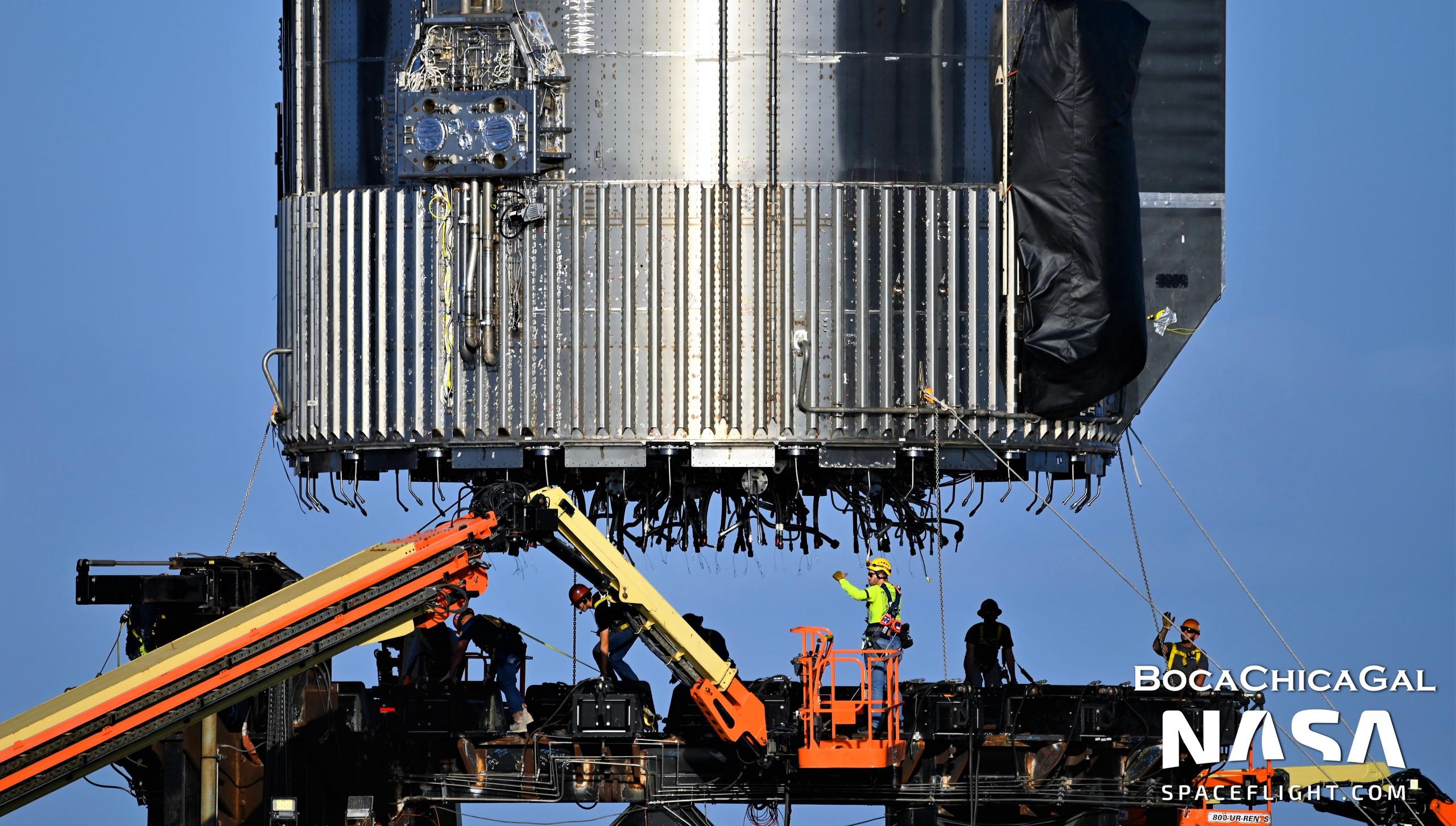
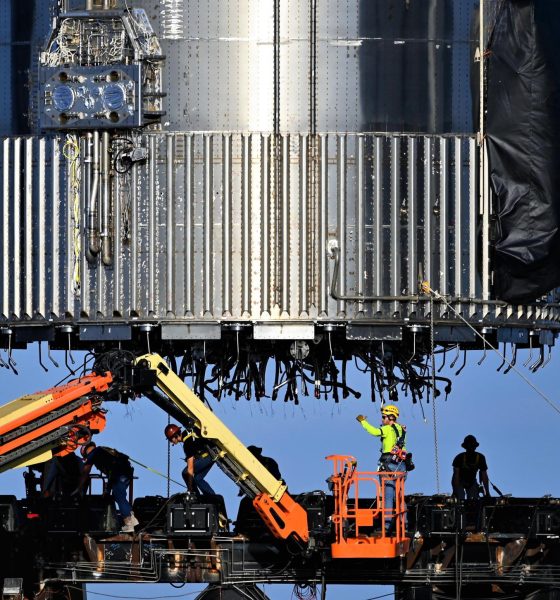
News
SpaceX begins installing new ‘Raptor 2’ engines on Super Heavy booster
SpaceX has begun installing new ‘Raptor 2’ engines on Super Heavy Booster 7 after the prototype completed a range of tests and returned to the company’s South Texas ‘Starbase’ rocket factory.
Earlier this month, SpaceX transported Booster 7 (B7) in the opposite direction, returning the 67-meter (~220 ft) tall rocket to Starbase’s orbital launch site (OLS) for the second time after it was forced to head back to the factory for repairs. Repairs completed, SpaceX dove headfirst into the process of verifying that the booster had been returned to full health and immediately filled its tanks to the brim with at least 3000 tons (>6.5M lb) of liquid nitrogen and oxygen – better known as a cryogenic proof test.
Less than 48 hours after completing its first post-repair test, Booster 7 sailed through another full cryoproof test without losing a beat. On May 13th, two days later, SpaceX attached a crane to Super Heavy B7 and removed it from the orbital launch mount before rolling the rocket back to Starbase’s build site on May 14th. Without official confirmation, which is increasingly rare, it was impossible to determine the results of the testing with certainty, but the speed of the process and Booster 7’s rapid launch mount removal made the two most extreme outcomes the most likely.
A quick return to the build site could have been explained by a significant vehicle failure or a major issue with SpaceX’s repair job – no point in continuing to test a vehicle that can’t be fully tested. On the exact opposite hand, a near-perfect test campaign in which all objectives were more or less achieved without major hiccups could also explain the quick return. In general, the evidence was in favor of the more optimistic explanation. Had a major issue been uncovered during the first post-repair cryoproof, it’s difficult to imagine that SpaceX would have completed the exact same test – in full less than 48 hours later.
However, SpaceX moved an in-situ Raptor engine installation stand towards Booster 7 and the orbital launch mount shortly before testing restarted, hinting – for the moment – that the company wanted to begin installing Raptor engines immediately after cryoproof testing. But mid-way through testing, the stand was moved back to its storage area and Super Heavy was instead removed from the mount and returned to the factory, adding a little uncertainty.
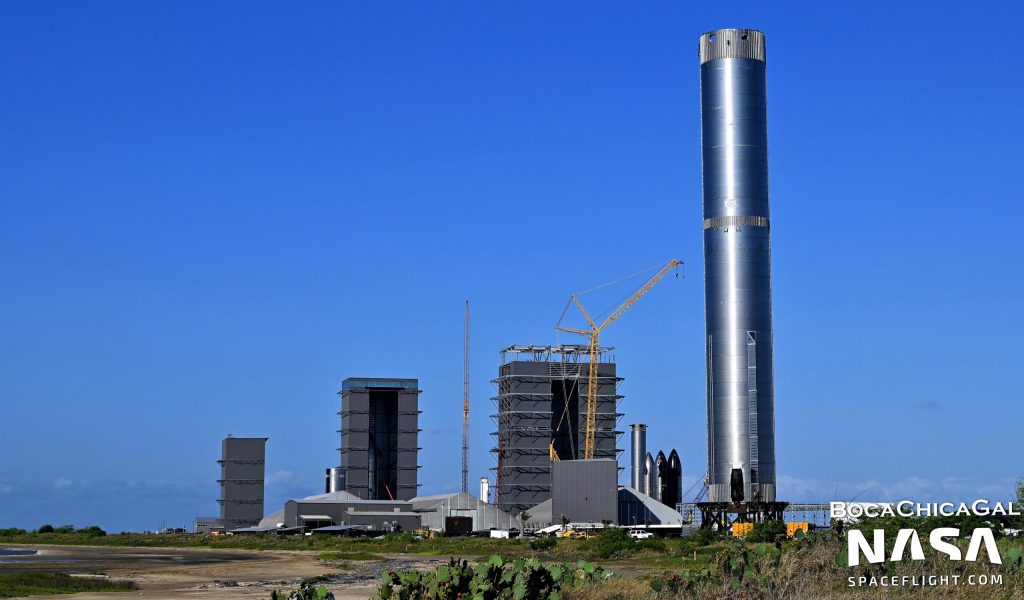
Concerns were immediately assuaged on May 17th when SpaceX was spotted moving Raptor engines from a production tent to the ‘megabay’ assembly building containing Booster 7. While the location of the new bay makes it difficult to peek inside from public viewpoints, preventing direct confirmation, it’s very likely SpaceX has begun installing new Raptor 2 engines on Super Heavy B7.
Additionally, confirming some of the more optimistic speculation about SpaceX’s decision to move Booster 7 back to build site, two of the three Raptor engines spotted on May 17th were also labeled “E26” and “E28.” Unless SpaceX’s engine numbering conventions have changed, the labels identify the engines as three of 20 ‘Raptor Boost’ engines that will ultimately populate the outer ring of Super Heavy B7’s aft end. More importantly, the installation of any Raptor Boost 2 (RB2) engines likely indicates that SpaceX has decided to install a full set of 33 Raptors on the booster before kicking off static fire testing.
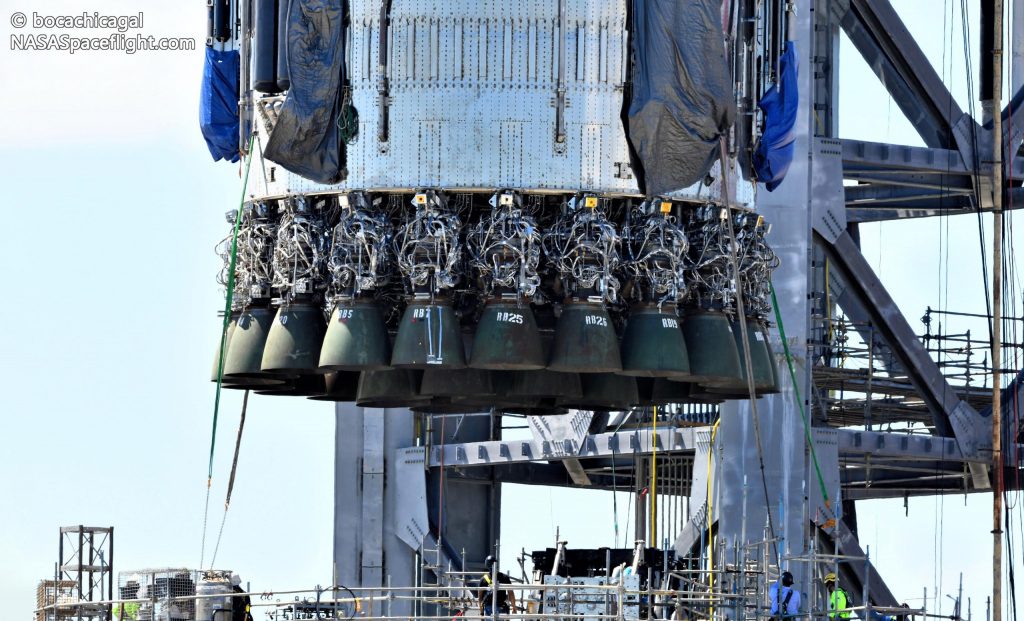
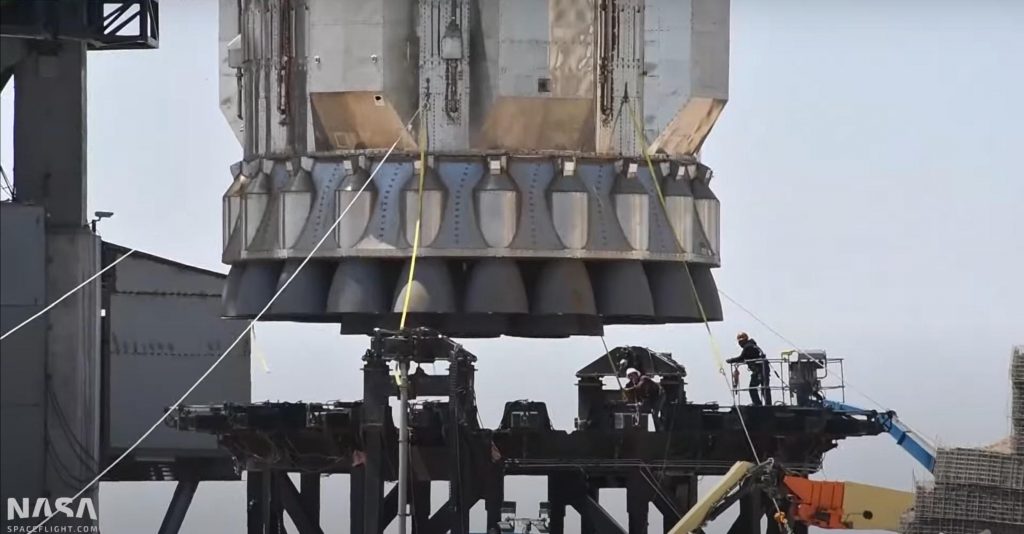
To limit risk, SpaceX could have begun test-firing Booster 7 with just 1-3 Raptor engines installed and gradually added more as confidence grew. Instead, SpaceX appears to have accepted the added risk of losing 33 brand-new Raptor 2 engines in one fell swoop in return for the possibility of a much faster test campaign. If there are no major surprises during static fire testing, in other words, Booster 7 could be ready for flight far more quickly if the process begins with all 33 engines already installed. Installing Booster 7’s Raptors, heat shield, and aerocovers will be easier back at the build site.
Doing it all at once should also help prevent Booster 7 from suffering Booster 4’s fate and wallowing, unfinished, for months without completing a single useful test. If the gamble works, the first stage of a two-stage Starship could be ready for an orbital launch attempt in just a few months. If the gamble fails and Booster 7 is damaged, destroyed, or otherwise unable to pass the necessary tests, SpaceX will simply move on to Booster 8 sooner than later, having wasted less time on a more cautious Booster 7 test campaign.
It’s unclear how long it will take SpaceX to install all 33 Raptors, construct a heat shield around those engines, and finish buttoning up the rest of Booster 7. In an adjacent assembly bay, SpaceX appears to have nearly finished assembling a similarly upgraded Starship – Ship 24 – that’s first in line to ride Booster 7 into space. The company has also tentatively requested road closures for three 12-hour test windows on May 23rd, 24th, and 25th that either vehicle could use.

Elon Musk
Starlink achieves major milestones in 2025 progress report
Starlink wrapped up 2025 with impressive growth, adding more than 4.6 million new active customers and expanding service to 35 additional countries, territories, and markets.

Starlink wrapped up 2025 with impressive growth, adding more than 4.6 million new active customers and expanding service to 35 additional countries, territories, and markets. The company also completed deployment of its first-generation Direct to Cell constellation, launching over 650 satellites in just 18 months to enable cellular connectivity.
SpaceX highlighted Starlink’s impressive 2025 progress in an extensive report.
Key achievements from Starlink’s 2025 Progress
Starlink connected over 4.6 million new customers with high-speed internet while bringing service to 35 more regions worldwide in 2025. Starlink is now connecting 9.2 million people worldwide. The service achieved this just weeks after hitting its 8 million customer milestone.
Starlink is now available in 155 markets, including areas that are unreachable by traditional ISPs. As per SpaceX, Starlink has also provided over 21 million airline passengers and 20 million cruise passengers with reliable high-speed internet connectivity during their travels.
Starlink Direct to Cell
Starlink’s Direct to Cell constellation, more than 650 satellites strong, has already connected over 12 million people at least once, marking a breakthrough in global mobile coverage.
Starlink Direct to Cell is currently rolled out to 22 countries and 6 continents, with over 6 million monthly customers. Starlink Direct to Cell also has 27 MNO partners to date.
“This year, SpaceX completed deployment of the first generation of the Starlink Direct to Cell constellation, with more than 650 satellites launched to low-Earth orbit in just 18 months. Starlink Direct to Cell has connected more than 12 million people, and counting, at least once, providing life-saving connectivity when people need it most,” SpaceX wrote.
News
Giga Nevada celebrates production of 6 millionth drive unit
To celebrate the milestone, the Giga Nevada team gathered for a celebratory group photo.

Tesla’s Giga Nevada has reached an impressive milestone, producing its 6 millionth drive unit as 2925 came to a close.
To celebrate the milestone, the Giga Nevada team gathered for a celebratory group photo.
6 million drive units
The achievement was shared by the official Tesla Manufacturing account on social media platform X. “Congratulations to the Giga Nevada team for producing their 6 millionth Drive Unit!” Tesla wrote.
The photo showed numerous factory workers assembled on the production floor, proudly holding golden balloons that spelled out “6000000″ in front of drive unit assembly stations. Elon Musk gave credit to the Giga Nevada team, writing, “Congrats on 6M drive units!” in a post on X.
Giga Nevada’s essential role
Giga Nevada produces drive units, battery packs, and energy products. The facility has been a cornerstone of Tesla’s scaling since opening, and it was the crucial facility that ultimately enabled Tesla to ramp the Model 3 and Model Y. Even today, it serves as Tesla’s core hub for battery and drivetrain components for vehicles that are produced in the United States.
Giga Nevada is expected to support Tesla’s ambitious 2026 targets, including the launch of vehicles like the Tesla Semi and the Cybercab. Tesla will have a very busy 2026, and based on Giga Nevada’s activities so far, it appears that the facility will be equally busy as well.
News
Tesla Supercharger network delivers record 6.7 TWh in 2025
The network now exceeds 75,000 stalls globally, and it supports even non-Tesla vehicles across several key markets.

Tesla’s Supercharger Network had its biggest year ever in 2025, delivering a record 6.7 TWh of electricity to vehicles worldwide.
To celebrate its busy year, the official @TeslaCharging account shared an infographic showing the Supercharger Network’s growth from near-zero in 2012 to this year’s impressive milestone.
Record 6.7 TWh delivered in 2025
The bar chart shows steady Supercharger energy delivery increases since 2012. Based on the graphic, the Supercharger Network started small in the mid-2010s and accelerated sharply after 2019, when the Model 3 was going mainstream.
Each year from 2020 onward showed significantly more energy delivery, with 2025’s four quarters combining for the highest total yet at 6.7 TWh.
This energy powered millions of charging sessions across Tesla’s growing fleet of vehicles worldwide. The network now exceeds 75,000 stalls globally, and it supports even non-Tesla vehicles across several key markets. This makes the Supercharger Network loved not just by Tesla owners but EV drivers as a whole.
Resilience after Supercharger team changes
2025’s record energy delivery comes despite earlier 2024 layoffs on the Supercharger team, which sparked concerns about the system’s expansion pace. Max de Zegher, Tesla Director of Charging North America, also highlighted that “Outside China, Superchargers delivered more energy than all other fast chargers combined.”
Longtime Tesla owner and FSD tester Whole Mars Catalog noted the achievement as proof of continued momentum post-layoffs. At the time of the Supercharger team’s layoffs in 2024, numerous critics were claiming that Elon Musk was halting the network’s expansion altogether, and that the team only remained because the adults in the room convinced the juvenile CEO to relent.
Such a scenario, at least based on the graphic posted by the Tesla Charging team on X, seems highly implausible.








